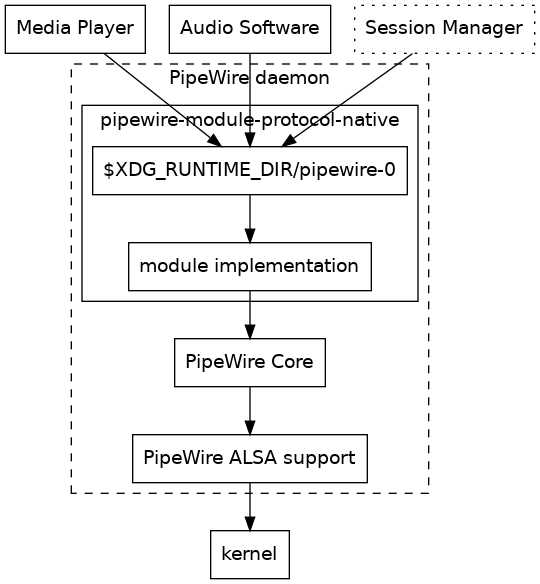The PipeWire daemon is the central process that manages data exchange between devices and clients.
Typically general, users run one PipeWire daemon that listens for incoming connections and manages devices. Clients (including the PipeWire Session Manager) are separate processes that talk to the daemon using the PipeWire socket (default: $XDG_RUNTIME_DIR/pipewire-0). This approach provides provides address-space separation between the privileged daemon and non-privileged clients.

As shown above, the protocol is handled by the PipeWire Module: Protocol Native. From PipeWire's point-of-view this module is just another module.
Configuration Files
On startup, the daemon reads a configuration file to configure itself. It executes a series of commands listed in the config file. The lookup order for configuration files are:
$XDG_CONFIG_HOME/pipewire/pipewire.conf(usually$HOME/.config/pipewire/pipewire.conf)$sysconfdir/pipewire/pipewire.conf(usually/etc/pipewire/pipewire.conf)$datadir/pipewire/pipewire.conf(usually/usr/share/pipewire/pipewire.conf)
The first configuration file found is loaded, the PipeWire daemon does not currently combine configuration files.
The environment variables PIPEWIRE_CONFIG_DIR, PIPEWIRE_CONFIG_PREFIX and PIPEWIRE_CONFIG_NAME can be used to specify an alternative config directory, subdirectory and filename, respectively.
Configuration File Format
PipeWire's configuration file format is JSON. In addition to true JSON, PipeWire also understands a more compact JSON representation where " can be omitted around strings, no trailing commas are required and : or = can be used to separate object keys from their values. Also, # can be used to start a comment until the end of the line.
The configuration file format is grouped into sections. A section is either a dictionary ({}) or an array ([]). Dictionary and array entries are separated by whitespace and may be simple value assignment, an array or a dictionary. For example:
Allowed configuration file sections are:
- context.properties (dictionary): These properties configure the pipewire instance.
- context.spa-libs (dictionary): Maps plugin features with globs to a spa library.
- context.modules (array): Each entry in the array is a dictionary with the name of the module to load, including optional args and flags. Most modules support being loaded multiple times.
- context.objects (array): Each entry in the array is a dictionary con‐ taining the factory to create an object from and optional extra argu‐ ments specific to that factory.
- context.exec (array): Each entry in the array is dictionary containing the path of a program to execute on startup and optional args. This ar‐ ray usually contains an entry to start the session manager.
Logging
The PIPEWIRE_DEBUG environment variable can be used to enable more debugging. The format is:
<level>[<category>;...]
<level>specifies the log level:0: no logging is enabled1: Error logging is enabled2: Warnings are enabled3: Informational messages are enabled4: Debug messages are enabled5: Trace messages are enabled. These messages can be logged from the realtime threads.
<category>: Specifies a string category to enable. Many categories can be separated by commas. Current categories are:connection: to log connection messages